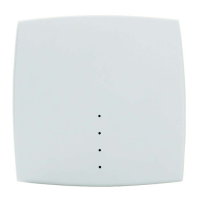Installation, Administration and Maintenance
Aastra Telecom Page: 16 (47)
2.7 About the Portable Parts
Portable Part (PP) is DECT standard terminology and in the context of the
Aastra SIP-DECT
TM
solution is interchangeable with Aastra DECT 142
Handset / Aastra Phone 142.
Please be aware of differences in regulatory requirements between North
America and all other areas of the world. These differences lead to different
PP variants which use specific frequency bands and field strengths:
• Aastra DECT 142 (NA)
- Frequency Band 1920 to 1930 MHz
- 60 duplex channels
- 100 mW (maximum output per active channel)
- 5 mW (average output per active channel)
• Aastra Phone 142 (EMEA)
- Frequency Band 1880 to 1900 MHz
- 120 duplex channels
- 250 mW (maximum output per active channel)
- 10 mW (average output per active channel)
In addition to the Aastra DECT 142 Handset / Aastra Phone 142, standard
3rd party DECT GAP phones may operate on the Aastra SIP-DECT
TM
solution. But the functionality may be limited by the characteristics of the 3rd
party DECT phone.
2.8 System capacities
There is only one OpenMobility Manager (OMM) in the system. The OMM
capacities are:
• Up to 256 RFPs (Access Points) can be controlled.
• Up to 512 PPs (Handsets) are handled.
It is possible to deactivate the DECT part of a RFP. If the DECT interface is
deactivated then the resources (CPU and memory) are available for the
OMM only.

